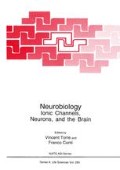Abstract
Artificial neuronal networks provide attractive models for cortical function, in particular, if “cognitive” properties emerge from their structure. Unfortunately, it turns out difficult to set up classical models which are comparable to the biological system on the level of single neurons. We look at artificial neuronal networks from a fresh perspective, which has the potential to extend their merits to a detailed and quantitative description of physiological phenomena in nerve nets of spiking neurons. In fact, the framework of stochastic point processes provides the tools for the construction of mathematically consistent models, which allow for a direct comparison with electrophysiological recordings on the level of individual nerve cells, in particular, if these are part of a large network. Moreover, the estimation of model parameters from experiments becomes feasible, so that a quantitative theoretical treatment as well as computer simulations of large networks under realistic conditions can be undertaken.
Access this chapter
Tax calculation will be finalised at checkout
Purchases are for personal use only
Preview
Unable to display preview. Download preview PDF.
References
Abeles M, Bergman H, Margalit E, Vaadia E (1993) Spatiotemporal firing patterns in the frontal cortex of behaving monkeys. J Neurophysiol 70:1629–1638
Abeles M, Prut Y, Bergman H, Vaadia E, Aertsen A (1993) Integration, synchronicity and periodicity. In: Aertsen A (ed.) Brain Theory: Spatio-Temporal Aspects of Brain Function. 149–181. Amsterdam, New York, London, Tokyo: Elsevier
Artola A, Bröcher S, Singer W (1990) Different volatage-dependent thresholds for inducing long-term depression and long-term potentiation in slices of rat visual cortex. Nature 347:69–72
Bernander ö, Douglas RJ, Martin KAC, Koch C (1991) Synaptic background activity influences spatiotemporal integration in single pyramidal cells. Proc Natl Acad Sci USA 88:11569–11573
Braitenberg V (1974) On the representation of objects and their relations in the brain. In: Conrad M, Güttinger W, Dallin M (eds.) Physics and Mathematics of the Nervous System. 290–298. Berlin, Heidelberg, New York: Springer.
Braitenberg V, Schüz A (1991) Anatomy of the Cortex—Statistics and Geometry. Studies of Brain Function, vol. 18. Berlin, Heidelberg, New York: Springer
Clay JR, DeFelice LJ (1983) Relationship between membrane excitability and single channel open-close kinetics. Biophys J 42:151–157
Daley DJ, Vere-Jones D (1988) An Introduction to the Theory of Point Processes. Springer Series in Statistics. New York: Springer
Hille B (1992) Ionic Channels of Excitable Membranes (2nd ed.) Sunderland (MA): Sinauer
Hopfield JJ (1982) Neural networks and physical systems with emergent collective computational abilities. Proc Natl Acad Sci USA 79:2554–2558
Koch C, Segev I (1989) Methods in Neuronal Modeling—From Synapses to Networks. Cambridge: MIT-Press
Little WA (1974) The existence of persistent states in the brain. Math Biosci 19:101–120
Mainen ZF, Sejnowski TJ (1995) Reliability of spike timing in neocortical neurons. Science 268:1503–1506
McCormick DA, Connors BW, Lighthall JW, Prince DA (1985) Comparative electrophysiology of pyramidal and sparsely spiny stellate neurons of the neocortex. J Neurophysiol 54:782–806
McCulloch WS, Pitts W (1943) A logical calculus of the ideas immanent in nervous activity. Bull Math Biophys 5:115–133
Mirollo RE, Strogatz SH (1990) Synchronization of pulse-coupled biological oscillators. SIAM J Appl Math 50:1645–1662
Perkel DH, Gerstein GL, Moore GP (1967) Neuronal spike trains and stochastic point processes. I. The single spike train. Biophys J 7:391–418
Perkel DH, Gerstein GL, Moore GP (1967) Neuronal spike trains and stochastic point processes. II. Simultaneous spike trains. Biophys J 7:419–440
Reyes AD, Fetz EE (1993) Effects of transient depolarizing potentials on the firing rate of cat neocortical neurons. J Neurophysiol 69:1673–1683
Reyes AD, Fetz EE (1993) Two modes of interspike interval shortening by brief transient depolarizations in cat neocortical neurons. J Neurophysiol 69:1661–1672
Ripley BD (1987) Stochastic Simulation. Wiley Series in Probability and Mathematical Statistics. New York: Wiley
Rotter S, Heck D, Aertsen A, Vaadia E (1993) A stochastic model for networks of spiking cortical neurons: Time-dependent description on the basis of membrane currents. In: Eisner N, Heisenberg M (eds.) Gene—Brain—Behavior. No. 491. Stuttgart: Thieme
Rotter S (1994) Wechselwirkende stochastische Punktprozesse als Modell für neuronale Aktivität im Neocortex der Säugetiere. Reihe Physik, vol. 21. Frankfurt: Harri Deutsch
Shadlen MN, Newsome WT (1994) Noise, neural codes and cortical organization. Curr Opin Neurobiol 4:569–579
Softky WR, Koch C (1993) The highly irregular firing of cortical cells is inconsistent with temporal integration of random epsps. J Neurosci 13:334–350
Stuart GJ, Sakmann B (1994) Active propagation of somatic action potentials into neocortical pyramidal cell dendrites. Nature 367:69–72
Vaadia E, Haalman I, Abeles M, Bergman H, Prut Y, Slovin H, Aertsen A (1995) Dynamics of neuronal interactions in the monkey cortex in relation to behavioral events. Nature 373:515–518
Vaadia E, Bergman H, Abeles M (1989) Neuronal activities related to higher brain functions—theoretical and experimental implications. IEEE Transact Biomed Eng BME-36:25–35
Author information
Authors and Affiliations
Editor information
Editors and Affiliations
Rights and permissions
Copyright information
© 1996 Springer Science+Business Media New York
About this chapter
Cite this chapter
Rotter, S. (1996). Biophysical Aspects of Cortical Networks. In: Torre, V., Conti, F. (eds) Neurobiology. NATO ASI Series, vol 289. Springer, Boston, MA. https://doi.org/10.1007/978-1-4615-5899-6_28
Download citation
DOI: https://doi.org/10.1007/978-1-4615-5899-6_28
Publisher Name: Springer, Boston, MA
Print ISBN: 978-1-4613-7706-1
Online ISBN: 978-1-4615-5899-6
eBook Packages: Springer Book Archive

